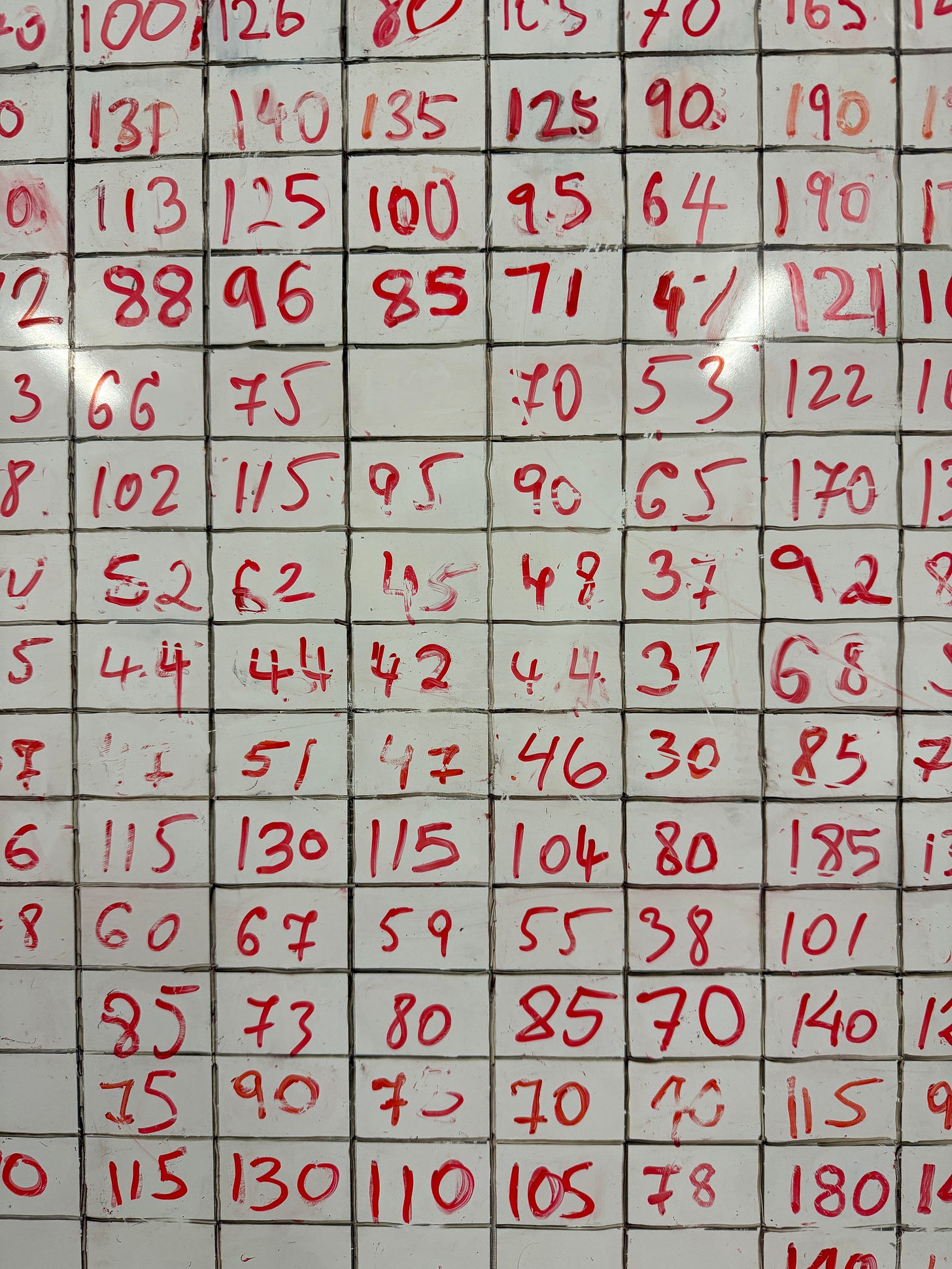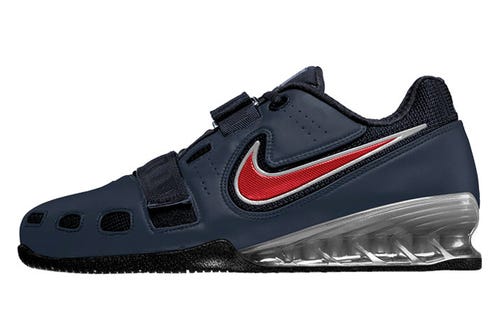The numbers
Numbers shape weightlifters. Not only do they quantify, they have other meanings. Here are some I’ve noticed.
Every weightlifting training session is mapped out by numbers. This number of exercises. This number of sets. This number of reps in each set. This percentage of weight to be lifted during those reps.
Power clean + push jerk
3 x 2.1 @ 75, 80, 85%
The numbers shape us. The wrong numbers can break. The right numbers spur ecstasy, momentarily. Once a number is achieved it is quickly superseded by another. No one is ever satisfied. What would be the point? Satisfaction in weightlifting must be experienced fleetingly, in small moments. It is not an end.
Not only do numbers quantify, they have other meanings. Some are relevant to all, some are relevant to a few. Here are some I’ve noticed.
Five
If asked to do five reps in a set, a weightlifter sometimes sees it as akin to being asked to perform high intensity cardio. Five reps is hard work. It is not enough for hypertrophy, but too many for sheer strength work.
One of the aims, as far as I understand it, is to perform a lift under fatigue, to test your technique. As footballers strive to improve their decision-making under fatigue and pressure, the surest way to ensure you lift a heavy weight is to lift a smaller one with perfect technique, five times.
Two
Weightlifters are very particular about shoes. It is a physical thing: you need the shoe that fits your foot, that has enough room across the toe box and enough height in the heel to accommodate the way in which you lift and your anatomy. But there is a hierarchy of shoes for purists. The Nike Romaleo 2 is a sought after shoe. Nike no longer make them, so there is a healthy second-hand market for these shoes in all sorts of condition.
Above: the Romaleo 2
Nike Romaleo 4s are the current version. A very serviceable shoe that will do the job for many lifters, but is still robust – and expensive – enough to please purists. No one wants the Romaleo 3. Its design broke with the two straps of the 2, going with one thick strap across the top of the foot. It didn’t work. The 4 returned to two straps and re-ignited the reputation of Nike as a weightlifting shoe. I have no particular opinion about shoes (but yes, I wear Roms), so don’t be telling me that this or that shoe is better. But show me a weightlifter who doesn’t understand or at least acknowledge the cult of the Rom 2.
Some people write their desired ‘totals’ for the two lifts on the heels of their shoes to provide motivation; a rude personalisation of an expensive shoe. (But given you can’t see the back of your shoe when you lift, I have always wondered how effective it is. Why not write it on the top of the toe?) Others get lifters to sign their shoes. Weightlifting shoes are not just functional, they are symbols. The 2 is perhaps, at the moment, one of the biggest. (See also the ASICS 727)
THREE
The attempts you are granted, in order to have your attendance count in a weightlifting competition. Three snatches, three clean and jerks. Miss all three snatch attempts and you are out. You can’t do the clean and jerks, not even to save face. What would be the point? Missing all three is sometimes called “bombing out”.
I’ve watched people bomb. It’s like watching a car crash in your dreams. You can’t do a thing about it and you’re pretty sure it’s not going to end well.
That’s what I thought. Until I was in the warm up room after an Atletika lifter bombed and she had already turned her mind to turning up to training on Monday. You just keep going.
Eighty Six (plus)
The highest weight class for female Olympic weightlifters. Sometimes called the “super heavies”. It doesn’t hold the same allure or demand as much respect as that of men. Consider this, said to me recently by a female weightlifter:
“As someone who has only lifted as a super, I’m used to the numbers I lift being invalidated by others because of the number I weigh. I barely ever post my lifts online because, as a super, nothing I do is perceived as being as impressive as a lighter lifter. I’m losing weight now and I’m terrified of how much strength I might lose. The voice of doubt in my head says, “What if I’m not actually good at weightlifting, I was just heavy?” As I get lighter (and recovering from an injury), I’m having to respect that lighter weights feel heavier now. It’s all a bit of a mind fuck.”
It sure is. And not just because sometimes the same weight can be heavy, or light.
Why is it that a larger woman, lifting big weights, is just doing it “because she’s heavy” (combined with all the cultural disapproval that goes along with being “heavier”), whereas someone like Lasha Talakhadze – at 183kg - is considered superhuman? Not to discount Lasha’s achievements. He IS superhuman. But so are the super heavy women.
One
The amount of reps you do when attempting a max. I’ve written about maxing out before. Maxes still hold promise for me but I’ve had to train myself to not worry about them too much. I can’t hold them as my only weightlifting goal, because I would give up. My goal at the moment, is to keep going. This is particular to my situation. For others, the one rep max is still the whole point.
Consider another – albeit younger – lifter:
“Numbers are the reason I’m lifting. If I could never PB again I would stop lifting and try something else. The chance to tangibly improve, and show that improvement to the world, is like the sun around which everything else orbits for me.”
Thirty six
The plan is this: in thirty-six days I will compete.
When I say ‘compete’ I mean: I will turn up, I will warm up and I will attempt three lifts. If I am successful on one of those, I will attempt three more. I’m not aiming to compete with anyone. I don’t even want to compete with myself.
I have not improved my snatch or clean and jerk in over two years. Regular readers will know that I have a knack for injuring myself. This is due to my age – a number that has begun to haunt – but more so my stubbornness, ignorance and sheer stupidity. I’ve been hesitant about this comp – or any comp really – because I have this idea that I want to lift a certain weight. A certain number.
Coach Evie has been working with me, asking me how I would feel if I lifted this number, would I be ok with that? What she means is: you should be ok with that because the numbers are not the point.
Putting on that suit and walking out onto that platform, after everything else that’s happened, is the point.
Thank you, as always, for reading.
Georg x
Here’s the link to ‘buy me a coffee’ (make a small, one-off contribution) if you think sometimes I should be paid to write and you’d like to contribute to my knee physio fund.



Why am I surprised when weightlifters wax philosophical? We never expect brain and brawn to coexist? Just delightful to have the conjunction.